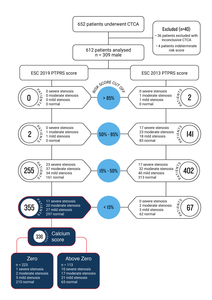Fyyaz, S; Rasoul, H; Miles, C; Olabintan, O; David, S; Plein, S; Alfakih, K
(2021)
ESC 2019 guidelines on chronic coronary syndromes: could calcium scoring improve detection of coronary artery disease in patients with low risk score. Findings from a retrospective cohort of patients in a district general hospital.
JRSM Cardiovasc Dis, 10.
p. 20480040211032789.
ISSN 2048-0040
https://doi.org/10.1177/20480040211032789
SGUL Authors: Miles, Christopher Jason
|
PDF
Published Version
Available under License Creative Commons Attribution Non-commercial. Download (318kB) | Preview |
|
![[img]](https://openaccess.sgul.ac.uk/113546/6.hassmallThumbnailVersion/sj-jpg-1-cvd-10.1177_20480040211032789.jpg)
|
Image (JPEG) (Supplemental material)
Published Version
Available under License Creative Commons Attribution Non-commercial. Download (1MB) | Preview |
Abstract
Background: The European Society of Cardiology (ESC) published an updated stable chest pain guideline in 2019, recommending the use of an updated pre-test probability (PTP) risk score (RS) to assess the likelihood of coronary artery disease (CAD). We sought to compare the 2019 and 2013 PTPRS in a contemporary cohort of patients. Methods: 612 patients who were investigated with computed tomography coronary angiography (CTCA) for stable chest pain were included in a retrospective analysis. Results: There were 255 patients with 2019 PTPRS 15-50% with a 9% yield of severe CAD on CTCA, compared with 402 patients and a 4% yield using the 2013 PTPRS (p = 0.01). 355 patients had a 2019 PTPRS of <15%, with 3% found to have severe CAD, compared with 67 patients and none with severe CAD using the 2013 PTPRS (p = 0.14). 336 of patients with 2019 PTPRS of <15% had a calcium score as part of the CTCA. 223 of these had a zero calcium score and only one had severe CAD. In comparison, 113 patients had a positive calcium score, and 10 (9%) had severe CAD (p < 0.001). Discussion: The ESC 2019 PTPRS classifies more patients as at lower risk of CAD and hence reduces the risk overestimation associated with the 2013 PTPRS. However, in patients with a 2019 PTPRS of <15%, who would not be investigated, the use of the calcium score detected the majority of patients with significant CAD, who may benefit from secondary prevention and an associated mortality benefit as per the SCOT-Heart trial.
| Item Type: | Article | ||||||||
|---|---|---|---|---|---|---|---|---|---|
| Additional Information: | © The Author(s) 2021 https://creativecommons.org/licenses/by-nc/4.0/Creative Commons Non Commercial CC BY-NC: This article is distributed under the terms of the Creative Commons Attribution-NonCommercial 4.0 License (https://creativecommons.org/licenses/by-nc/4.0/) which permits non-commercial use, reproduction and distribution of the work without further permission provided the original work is attributed as specified on the SAGE and Open Access pages (https://us.sagepub.com/en-us/nam/open-access-at-sage). | ||||||||
| Keywords: | Coronary artery disease, chronic ischaemic heart disease, calcium score, computed tomography coronary angiography, atherosclerosis, pre-test probability risk score, functional testing | ||||||||
| SGUL Research Institute / Research Centre: | Academic Structure > Molecular and Clinical Sciences Research Institute (MCS) | ||||||||
| Journal or Publication Title: | JRSM Cardiovasc Dis | ||||||||
| ISSN: | 2048-0040 | ||||||||
| Language: | eng | ||||||||
| Dates: |
|
||||||||
| Publisher License: | Creative Commons: Attribution-Noncommercial 4.0 | ||||||||
| PubMed ID: | 34349983 | ||||||||
 |
Go to PubMed abstract | ||||||||
| URI: | https://openaccess.sgul.ac.uk/id/eprint/113546 | ||||||||
| Publisher's version: | https://doi.org/10.1177/20480040211032789 |
Statistics
Actions (login required)
 |
Edit Item |


